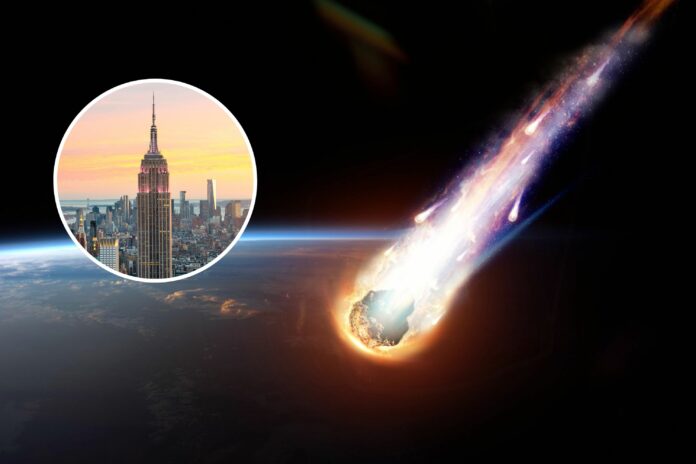A huge “potentially hazardous asteroid” about as wide as the Empire State Building’s height is due to zoom past the Earth on Friday.
This asteroid, named 2008 OS7, is estimated to be between 690 and 1,570 feet across, according to data from NASA’s Center for Near-Earth Object Studies (CNEOS). The Eiffel Tower is about 980 feet, while the Empire State Building is 1,250 feet tall.
This asteroid will pass by the Earth at a distance of around 0.01908 astronomical units, or about 1.77 million miles. For reference, the moon orbits at a distance of 240,000 miles, while our planetary neighbor Venus is 38 million miles away at its closest point.
ISTOCK / GETTY IMAGES PLUS
The asteroid 2008 OS7 will make its closest flyby in the afternoon of February 2 and will pass Earth at a speed of about 18.2 km/s, or 40,700 mph. A speeding bullet, in comparison, can travel at between 600 and 2,000 mph.
Asteroids are chunks of rock left over from the formation of the solar system, most of which are found in the Asteroid Belt between Mars and Jupiter. Most of these asteroids are fairly small, but some are enormous: the largest is named Ceres and is about 600 miles across. Occasionally, Jupiter’s gravity or collisions will fling one of these asteroids into the inner solar system, sending them careening past Earth.
The asteroid 2008 OS7 is classified as both a “Near Earth Object” (NEO) and a “potentially hazardous asteroid” (PHA) due to its size and how close it will come to the Earth. NEOs are defined as being within 30 million miles of Earth, with 31,000 solar system objects falling into this category. PHAs, on the other hand, are closer than 4.6 million miles and are also larger than 460 feet in diameter. Around 2,350 PHAs are being tracked by NASA.
“A potentially hazardous asteroid (PHA) is one that has an orbit intersecting the Earth’s orbit around the Sun by less than 0.05 astronomical units (1 AU is the distance to the Sun), that’s just over 4.5 million miles. It also has to have an absolute brightness of 22.0 or less (lower values of the magnitude are brighter = larger objects), ie. an asteroid (or comet) that would cause significant regional damage if it hit the Earth,” Martin Barstow, a professor of astrophysics and space science at the University of Leicester in the U.K., told Newsweek. “Not all NEOs are potentially hazardous, but all hazardous objects are NEOs.”
The Earth will remain safe from 2008 OS7, however, as it won’t come anywhere close to colliding with our home world.
“2008 OS7, a very small asteroid whose orbit intersects with that of Earth, has been classified as a “Potentially Hazardous Asteroid (PHA)”,” Minjae Kim, a research fellow at the University of Warwick, said in a statement emailed to Newsweek.
“We don’t need to worry about it too much as this asteroid will not enter Earth’s atmosphere, while this will still approach close to the Earth. There are more than millions of asteroids in our Solar System, of which ~2,350 asteroids have been classified as PHAs. The next significant approach to Earth by a PHA will be the 99942 Apophis on April 14, 2029.”
For those keeping an eye on the skies, the 2008 OS7 will be disappointingly hard to spot.
“This asteroid completes an orbit around the sun every 962 days (2.63 years). One of the most intriguing aspects of the 2008 OS7 is its estimated diameter based on its luminosity and reflective properties, ranging from 0.221 to 0.494 kilometers,” Kim said.
“This places it in the category of a small to moderately-sized asteroid, roughly equivalent to the size of a football field. Unfortunately, asteroids are generally too faint to have been detected by the current techniques and surveys, so it’s very hard to see by our naked eye. The only asteroids at all visible to the naked eye so far are Pallas and Vesta, having diameters of about 500 km.”
Do you have a tip on a science story that Newsweek should be covering? Do you have a question about asteroids? Let us know via [email protected].
Uncommon Knowledge
Newsweek is committed to challenging conventional wisdom and finding connections in the search for common ground.
Newsweek is committed to challenging conventional wisdom and finding connections in the search for common ground.


